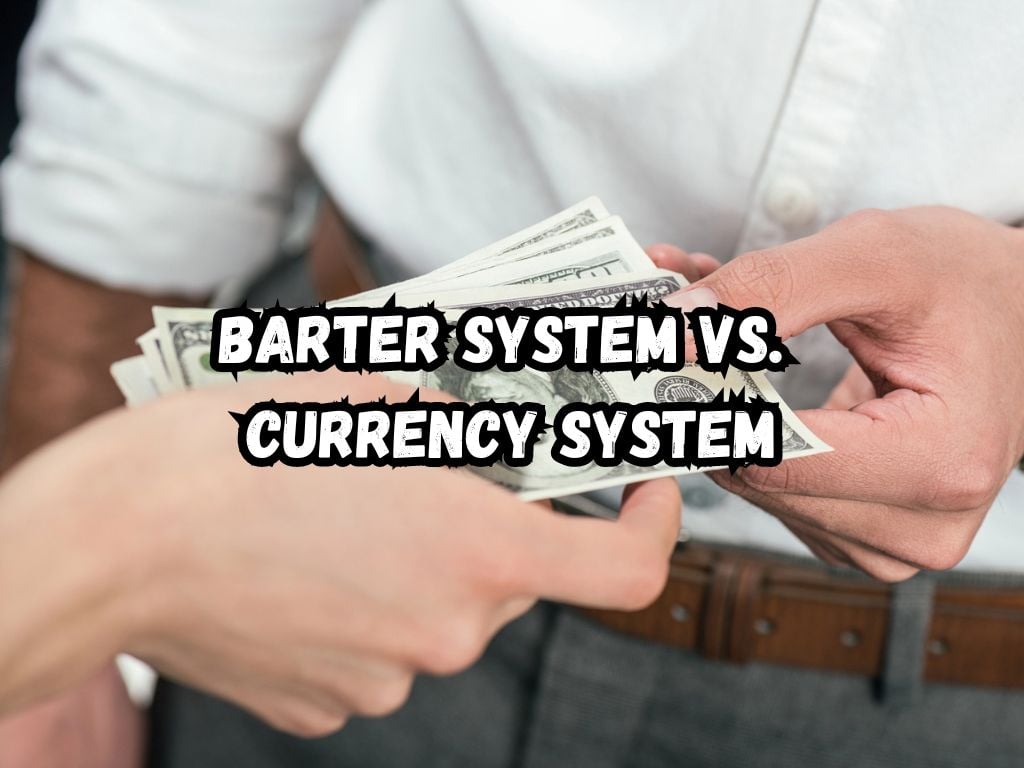Trade and exchange have been pillars of human civilization, evolving from simple barter of goods to the complex currency systems we see today.
This article delves into the mechanisms of the barter system vs currency system, highlighting their pros and cons, to offer a nuanced understanding of both.
Overview of the Barter System
Definition and Historical Context
The barter system is a method of trade where goods and services are directly exchanged for other goods and services without using a medium of exchange, like money.
Historically, this was the first form of commerce, predating monetary systems. Communities around the world relied on this system for thousands of years, trading items ranging from livestock to spices.

Advantages
One of the main advantages of the barter system lies in its simplicity and directness. It allows individuals to directly exchange goods or services that they have for what they need. There is no need for a standardized monetary system, making it free from the complexities of currency valuation and inflation.
Without a regulatory body or government oversight, the barter system is also free from central control. This simplicity could lead to more transparent transactions where the value is directly perceived by the participating parties.
Disadvantages
However, the barter system is not without its flaws. The most significant limitation is the need for a double coincidence of wants. This means both parties must have what the other desires, making transactions more complex and less frequent.
Storing wealth is also problematic in a barter system. Unlike money, which can be stored as cash or in banks, goods such as food or livestock can perish or lose value over time. This makes it difficult for individuals to build and maintain wealth.
Overview of the Currency System
Definition and Historical Evolution
The currency system involves the use of money as a medium of exchange. It has evolved from metal coins to paper money and, more recently, to digital forms. This evolution reflects humanity’s quest for a more efficient and scalable method of trade.
Advantages
Currency systems facilitate indirect exchange, which overcomes the limitations of barter. This vastly expands the scope of trading possibilities, as individuals can sell goods or services for currency, then use that currency to purchase what they need.
The ability to store wealth is significantly improved with currency. Money, particularly in its digital form, does not perish or degrade over time, making it a more secure way to maintain value.
Additionally, currency systems, being standardized and often government-backed, offer universally recognizable measures of value, simplifying trade on a global scale.
Disadvantages
However, currency systems are not immune to problems. Inflation and currency devaluation can erode the value of money, posing risks to both individuals and economies.
Furthermore, these systems rely heavily on the stability of governments and economic policies, making them vulnerable to policy changes and economic crises.
Barter System vs Currency System: Comparison
Ease of Use
While the barter system’s simplicity is appealing, its reliance on the double coincidence of wants makes transactions cumbersome.
The currency system, though it may seem complex at first glance, actually streamlines trade by eliminating this direct need for a want-coincidence.
Economic Efficiency
Currency systems promote economic efficiency by enabling clearer price setting, investment, and savings, which are challenging in a barter system.
The barter system’s limitations hinder the scope for investment and saving, essential components of economic growth.
Scope for Growth
The scalability of the currency system is evident in its ability to facilitate global trade. The barter system, limited by the need for direct exchanges, cannot easily support the high volume of transactions that modern economies require.

Modern Applications and Hybrid Systems
Today, we see a resurgence of barter in certain contexts, such as local exchange trading systems (LETS) and online bartering platforms.
These modern adaptations often incorporate elements of the currency system, indicating a move towards hybrid models.
Cryptocurrencies, like Bitcoin, represent this blend by allowing digital forms of barter on a global scale while maintaining the features of traditional money.
Frequently Asked Questions
What triggers a society to transition from a barter to a currency system?
Societies often shift to currency systems as they grow and trade becomes more complex, requiring a more scalable and efficient means of exchange.
Could a modern economy revert to a barter system?
While possible in small communities, a full-scale reversion is unlikely due to the inefficiencies in matching wants and the complexities of modern trade.
How do digital currencies fit into the comparison between barter and traditional currency systems?
Digital currencies blend aspects of both systems, offering the efficiency of currency with the peer-to-peer aspect of barter.
What are some real-world examples of successful barter economies today?
Certain local communities and online platforms have successfully implemented modern barter systems, showcasing their viability under specific conditions.
How do inflation and deflation impact barter and currency systems differently?
Inflation and deflation primarily affect currency systems by altering the value of money, whereas barter systems are immune to these phenomena but face their own unique challenges in valuing and exchanging goods directly.
By examining these systems side by side, we gain a better understanding of the intricacies of trade and value exchange.
Whether through barter or currency, the fundamental aim remains the same: to facilitate the exchange of goods and services, underscoring the interconnectedness of human societies.
Conclusion
From barter to currency, the journey of exchange systems mirrors the evolution of human society. Each system has its advantages and limitations, reflective of the contexts in which they developed.
With the advent of digital technologies, the lines between barter and currency blur, suggesting an exciting future for economic exchange systems.
As we reflect on this progression, it’s worth pondering whether a new system might one day surpass currency, combining the best of both worlds for a more efficient and equitable means of trade.


 Tags:
Tags:










